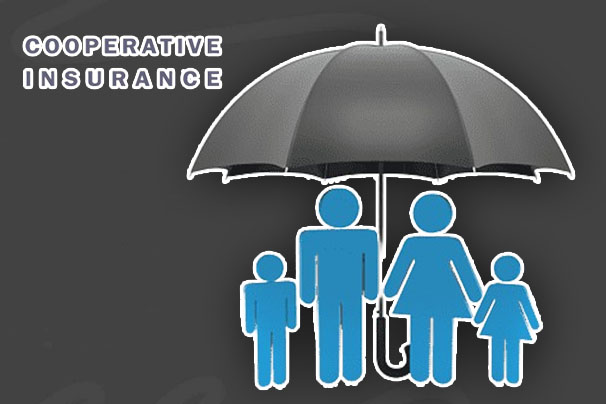
Cooperative insurance is a unique insurance model that provides coverage through a collective, member-focused approach. Unlike most traditional insurance companies driven by profit, cooperative insurance organizations aim to deliver affordable and reliable coverage by prioritizing the needs and welfare of their members.

Furthermore, this insurance represents a member-driven approach to financial protection, offering affordability, transparency, and community-focused benefits. While it may have limitations compared to traditional insurance, it excels in fostering trust and prioritizing member welfare.
What is Cooperative Insurance?
Cooperative insurance refers to an insurance system owned and operated by its members. These members pool their resources to provide financial protection against risks such as health issues, property damage, and accidents. Since the primary goal of cooperative insurance is to benefit its members rather than generate profit, it often provides lower premiums and tailored coverage options.
Features of Cooperative Insurance
Some of the key features that this model offers include:
- Member Ownership: The members are both policyholders and part-owners.
- Democratic Governance: Decisions are made collectively, meaning that every member has a say.
- Community Focus: Another feature of cooperative insurance is that it is geared toward serving specific communities or industries.
- Profit Redistribution: Surpluses are distributed among members or they are reinvested for their benefit.
How Does This Insurance Work?
Here are the step-by-step functions of how this insurance model works:
Membership-Based Model
To join a cooperative insurance organization, the individuals must first become members by buying a share or paying a membership fee. Furthermore, the membership gives them the right to participate in governance and access insurance benefits.
Pooling of Resources
Members contribute premiums to a collective fund managed by the cooperative. Also, the funds are used to pay claims and cover administrative costs.
Claims and Payouts
When a member experiences a covered event, like a medical emergency or property loss, they can file a claim. Next, the cooperative evaluates the claim and disburses funds accordingly.
If there is a surplus at the end of the fiscal year, it may be redistributed to members as dividends, used to improve services or reduce premiums, or invested in community projects or member education.
Benefits of This Insurance
Here are the benefits enjoyed by members who purchase the cooperative insurance model:
Cost-Effective Coverage
It provides lower premiums due to non-profit operations. What’s more, members save on administrative and marketing costs often incurred by traditional insurers.
Member-Centric Services
This insurance model has policies that are tailored to meet the unique needs of members. Also, they have greater transparency and accountability in operations.
Stronger Community Bonds
Another thing this insurance does is that it strengthens community relationships by encouraging mutual support.
Profit Redistribution
The surpluses benefit members instead of shareholders since it offer financial rewards or reduced premiums.
Limitations One May Face
Here are some challenges that members are likely to face because of this insurance model:
- It may not offer the extensive range of policies available through traditional insurers.
- A cooperative’s smaller pool of funds can limit its ability to handle high-value claims or large-scale catastrophes.
- Also, it often serves specific regions or industries, which limits accessibility for outsiders
- Mismanagement or lack of professional expertise may impact efficiency
- Democratic governance can slow decision-making processes.
Types of Cooperative Insurance
Here are the various types that exist:
- Health Insurance Cooperatives
- It provides medical coverage and health-related benefits. For example, the Group Health Cooperative in the U.S.
- Mutual Insurance Companies
- Similar to cooperatives, mutual insurance companies are member-owned but often operate on a larger scale.
- Property and Casualty Insurance Cooperatives
- This cooperative insurance covers property damage, liability, and accident-related risks.
- Agricultural Insurance Cooperatives
This protects farmers against crop failure, livestock loss, and natural disasters.
Cooperative Insurance Around the World
Here are some location dealings of this insurance model you can find around the world:
North America: This insurance is popular in industries like agriculture and health. Example: Nationwide Mutual Insurance Company in the U.S.
Europe: Many cooperatives are part of the International Cooperative and Mutual Insurance Federation (ICMIF). E.g.: the P&V Group in Belgium and La Macif in France.
Developing Countries: Cooperative insurance helps underserved communities access affordable coverage. Example: Microinsurance cooperatives in Africa and Asia.
Cooperative Insurance vs. Traditional Insurance
Here are the noticeable differences between the Cooperative insurance and Traditional insurance:
| Feature | Cooperative Insurance | Traditional Insurance |
| Premiums | Typically lower | Market-driven |
| Focus | Member welfare | Profit maximization |
| Decision-Making | Democratic | Controlled by executives |
| Profit Distribution | Shared with members | Retained by the company |
| Ownership | Owned by members | Owned by shareholders |
Frequently Asked Questions
Here are frequently asked questions you can check out:
Who can join this insurance organization?
The eligibility criteria vary. Some cooperatives serve specific professions, industries, or regions, while others are open to the general public.
Are cooperative insurance premiums cheaper than traditional insurance?
Yes, premiums are often lower due to the non-profit nature of cooperatives and their focus on reducing administrative costs.
How do I file a claim with an insurer?
The process is quite similar to traditional insurers. Members submit documentation of the incident, and the cooperative evaluates and processes the claim.